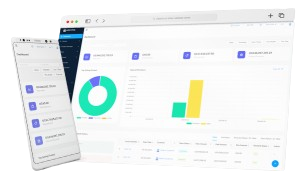Inventory optimization ensures your business has the right stock, in the right place, at the right time. It’s not just about cutting costs—it’s about balance. Excess inventory ties up resources and risks obsolescence, while insufficient stock leads to missed sales and dissatisfied customers.
With next-day delivery and rising customer expectations becoming the norm, businesses must adapt to rapid demand changes and supply chain disruptions. Inventory optimization empowers companies to stay competitive by improving efficiency, reducing waste, and leveraging data to make smarter decisions.
What is Inventory Optimization?
Inventory optimization is the process of strategically managing stock levels to maintain operational efficiency and profitability. It ensures businesses have just enough inventory to meet demand while minimizing costs and waste.
This involves using data-driven forecasting, automation, and advanced tools to balance supply with demand. By avoiding overstocking and understocking, businesses can improve cash flow, enhance customer satisfaction, and quickly adapt to market shifts—making inventory optimization a cornerstone of successful supply chain management.
The Difference Between Inventory Management and Inventory Optimization
Inventory management and inventory optimization are closely connected but serve different purposes within supply chain operations.
Inventory management focuses on overseeing stock across all stages—raw materials, work-in-progress, and finished goods. It ensures that inventory processes, like ordering and storage, run smoothly to meet productivity and operational goals.
Inventory optimization, on the other hand, zooms in on maximizing efficiency and profitability. It involves balancing supply and demand to reduce costs associated with surplus stock, minimize the risks of shortages, and avoid waste.
Think of inventory management as the broad framework that keeps operations functional, while inventory optimization fine-tunes the system to ensure you’re achieving the best financial and operational outcomes. Together, they create a comprehensive strategy that keeps your business agile and competitive.
Types of Inventory
Inventory isn’t just the finished products you see on store shelves—it spans everything a business needs to operate, produce, and deliver. Understanding the four main types of inventory is essential for effective management and optimization:
- Raw Materials:
These are the basic inputs used to create products, such as metals, fabrics, or chemicals. Without a steady supply of raw materials, production halts. - Work-in-Progress (WIP):
This includes items currently in the production process, such as partially assembled goods. Managing WIP inventory efficiently reduces bottlenecks and keeps production costs low. - Finished Goods:
These are the completed products ready for sale. Proper management ensures these goods are available to meet customer demand without overstocking. - Maintenance, Repair, and Operating (MRO) Supplies:
These are the tools, equipment, and materials needed to support production and operations, like machinery parts or cleaning supplies. While not part of the final product, MRO inventory is vital to keep everything running smoothly.
Each type of inventory plays a unique role in the supply chain. Optimizing all four ensures businesses can meet customer demands while minimizing waste and costs.
Challenges in Traditional Inventory Optimization
Traditional inventory optimization faces significant hurdles, often rooted in outdated practices and systems. These challenges make it difficult for businesses to strike the right balance between supply and demand:
- Limited Data Capabilities:
Legacy systems struggle to process large volumes of diverse data. Without advanced tools like AI and analytics, businesses lack the insights needed to predict demand accurately or respond to risks. - Fast-Changing Consumer Expectations:
Customers now expect faster delivery and personalized experiences. Traditional methods, designed for slower processes, can’t keep up with today’s accelerated supply chain dynamics. - Increased Competition:
Digital transformation enables businesses to scale quickly, leading to more competitors and tighter margins. Companies using outdated inventory strategies risk falling behind. - Global Disruptions:
Events like extreme weather, political instability, or pandemics expose vulnerabilities in traditional inventory systems. Without modern forecasting tools, businesses are unprepared for sudden shifts in demand or supply. - Balancing Stock Levels:
The age-old challenge remains: keeping “just enough” inventory without overstocking or running out. Traditional methods rely heavily on human analysis, which can’t match the precision of modern technology.
Overcoming these challenges requires smarter, connected solutions that deliver real-time insights, automate processes, and enhance accuracy across the supply chain. For this, I highly recommend ArmPOS, which features a powerful reporting system with customizable time filters, advanced analytics, and activity notifications to keep your inventory optimized.
Modern Tools and Technologies for Inventory Optimization
In the fast-paced world of supply chain management, traditional methods alone are no longer enough. Modern tools and technologies are transforming inventory optimization, making it smarter, faster, and more reliable.
Artificial Intelligence (AI) and Machine Learning (ML):
These technologies analyze vast amounts of data to identify patterns, predict demand, and adjust inventory levels in real-time. This minimizes errors and helps businesses stay ahead of fluctuations.
Cloud-Based Platforms:
With cloud connectivity, inventory data can be accessed and updated across multiple locations in real-time. This ensures greater visibility and collaboration among teams.
Predictive Analytics:
Advanced analytics tools forecast future demand based on historical data and market trends. They provide actionable insights that reduce overstocking and prevent shortages.
Internet of Things (IoT):
IoT-enabled devices, like sensors and trackers, provide live updates on stock levels, product movement, and storage conditions. This improves transparency and control over the inventory lifecycle.
Integrated Solutions:
Systems like ArmPOS combine reporting, analytics, and notifications to streamline inventory management. With its customizable filters and advanced analytics, businesses can gain deeper insights into stock movements and make data-driven decisions effortlessly.
By leveraging these modern tools, businesses can optimize inventory levels, reduce waste, and adapt quickly to market changes. These technologies are not just upgrades—they are essential for staying competitive in today’s dynamic environment.
Benefits of Effective Inventory Optimization
Effective inventory optimization delivers measurable improvements across the supply chain, enabling businesses to operate more efficiently and profitably. Key benefits include:
Reduced Costs:
By minimizing excess stock and avoiding shortages, businesses save on storage expenses, reduce waste, and eliminate costs associated with emergency restocking.
Improved Cash Flow:
Maintaining optimal inventory levels frees up capital, allowing businesses to reinvest in growth opportunities and improve financial stability.
Enhanced Customer Satisfaction:
Meeting demand consistently ensures customers receive their orders on time, boosting loyalty and reducing the risk of losing sales to competitors.
Greater Visibility:
Modern tools provide real-time insights into stock levels, locations, and movements. This transparency helps businesses make informed decisions and respond quickly to changes in demand.
Scalability:
Optimized inventory systems can adapt to business growth, seasonal fluctuations, or unexpected disruptions, ensuring operations remain seamless.
Higher Profit Margins:
By balancing supply and demand efficiently, businesses reduce markdowns on surplus stock and maximize the profitability of their inventory investments.
When inventory optimization is approached strategically, it transforms operations, aligning stock levels with business goals and market needs. For businesses ready to take the next step, embracing connected, data-driven solutions can unlock these benefits and drive long-term success.
Conclusion
Inventory optimization is no longer just a best practice—it’s a necessity for businesses aiming to stay competitive in today’s fast-paced market. By ensuring the right balance of stock to meet demand while minimizing costs and waste, businesses can achieve operational efficiency, improve customer satisfaction, and boost profitability.
Modern tools and technologies, like AI, predictive analytics, and integrated platforms, make this process more precise and reliable. These solutions empower businesses to adapt quickly to changes, overcome challenges, and maintain scalability as they grow.
Whether you’re looking to streamline processes, reduce risks, or enhance decision-making, inventory optimization offers a clear path to achieving these goals. The key is to embrace data-driven strategies and the right technologies to transform inventory from a challenge into a competitive advantage.






